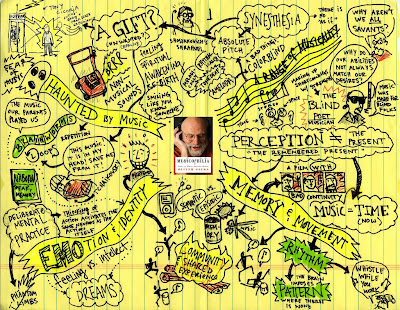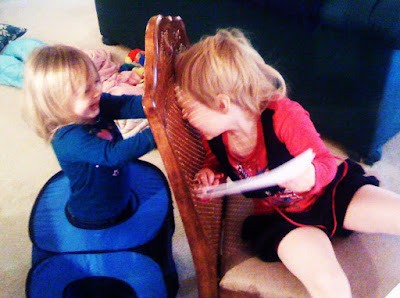Social construction, epistemology, narrative theory: FREEDOM
I didn't think about that experience again for 30 years--not until I took a philosophy class in seminary, and we read about epistemology. Whew! Suddenly that memory hit me like a ton of bricks!
How do we know things? How do we know anything?
Modernist thinking would say that we can know what really exists -- the table is real. Scientifically I can tell you what it's made of. Scientifically, we know what the human body is made of, and how we're put together. Freud said we are a combination of ego, id, superego and we function in certain ways because of certain drives inside of us. With modern thought, there's a certainty about the world, about reality itself.
Postmodern thought, on the other hand, would remind us that, after all, the ideas we have about the world, the language we use to communicate our ideas about the world, are not actually the world. They are merely our interpretations of what's real. Epistemology, that question of how I can know anything, begins with the fact that we are embodied creatures, with physical senses and a brain--a brain that takes in the raw data of experience from our eyes, ears, etc. and interprets it. We interpret everything.
We tend to not even be aware that we are interpreting, but a story from Oliver Sacks is a great reminder. Here's my version of Sacks' story:
This story illustrates how this construction process is going on all the time. We have various pieces of raw data coming into our brains from our five senses, and we take all of that data in and then have to interpret them. We construct our reality.It's the story of a man named Virgil. Virgil was in his 50's, and he'd been blind since he was a toddler. He and Amy were about to be married, and she convinced him to see her doctor, a surgeon who told Virgil that he could restore his sight. So, the day came, he had the surgery. He goes back the next day to have the bandages removed, and what do you think happened? It was a successful operation! Do you assume, as I did, that Virgil's eyes were opened, the scales fell from them, and the blind man received his sight?. Amy write in her journal about that great day: "Virgil can SEE! The entire office was in tears, first time Virgil has seen in 50 years! Miracle of sight restored! Incredible!"
But the following day, she wrote about certain problems: "Virgil's trying to adjust to seeing. He has to think faster. He's unsure of what seeing means."
In that first moment, when the bandages were removed, Virgil later said he had no idea what he was seeing. There was light, there was movement, there was color, all mixed up, all meaningless, a blur. Then out of the blue came a voice that said, "Well?" Only then did he realize that this chaos of light and shadow was a face, the face of his surgeon, bending over him, wanting to know if he could see!
When WE open our eyes each morning, it is upon a world we've spent a lifetime learning to see. We are not given the world -- we construct our world through incessant experience, categorization, memory. When Virgil opened his eyes, there were no visual memories to support a perception. He saw, but what he saw had no coherence. His retina and optic nerve were active, transmitting impulses, but his brain could make no sense of them.
He would get confused by his own shadow. The whole concept of shadows, of objects blocking light, was puzzling to him.
Steps posed a special hazard, because all he could see was a confusion, a flat surface of parallel and criss-crossing lines. He could not see them as solid objects going up or coming down in 3-dimensional space. There was a step at the end of his porch, which he knew occurred after a certain period of time. He had to coordinate both vision and the time necessary to cover the distance; if he walked too fast or too slow, he stumbled.He had a hard time distinguishing between his cat and dog, both of whom happened to be black and white. He'd look at the cat carefully, looking at its head, its ears, its paws, its tail, and touching each part gently as he did so…correlating, correlating…He could see each part, but could not see them all together; he couldn't connect them as a whole. Amy wrote that "you'd think once would be enough," but the visual recognitions kept slipping from his mind.
As Virgil explored and investigated the visual constructions of the world, he was like an infant moving his hand to and fro before his eyes, turning it this way and that in his primal construction of the world. Most of us have no sense of the immensity of the construction because we perform it unconsciously thousands of times a day, at a glance. But for Virgil (and for us as babies) this construction was a huge task of synthesizing, correlating varying appearances -- disconnected perceptions -- into a unified whole.
This construction is part of the narrative task. When we tell a story, we select from among a wide variety of data. There's always more involved in any human action than can be told, after all. And we construct the pieces into a story that has order and provides meaning. Narrative theory says that consciousness itself imposes a narrative structure on the 'flow of our experience.' And this structure is, of course, interwoven with temporality:
- Beginning, middle, end
- Past, present, future
- Memory, attention, anticipation
- We were, we are, we will be
- We're born, we live, we will die.
- The birth of all life on the planet, the present historical situation, the end/death of history
- The already, the present moment, the not yet.
So we set our experience inside this narrative structure that gives the experience some coherence and moves it through time.
Narrative theory says also that we maintain our sense of self, our sense of being a self, mostly through interpreting our lives as stories. Each of us has a story that is 'the story of my life.' That story embodies at least two things:
- The givens of our situation: we were born in the 20th century…these are our parents, our family, this is the genetic makeup we have…
- How we have interpreted and continue to reinterpret those givens, i.e., the meaning we bestow upon the givens, and on our experience
Several years ago I was an associate minister in a church in D_____. During the July Cabinet meeting we were talking about how the air conditioning in the church kept breaking. I was talking about how the Day Care Center at the church had lots of parents complaining. Next thing I know, one of the elders of the church verbally attacked me. Oh, he lit into me like there was no tomorrow. I was so shocked that I don't remember exactly what he said, but I do remember that he used the word "stupid." To me, it was completely out of the blue--a mean, ugly, angry outburst. I was devastated.
In terms of narrative theory and how we impose a narrative structure on the flow of experience, in the present I am sitting there at this Cabinet meeting, and I'm seeing and hearing this man's angry outburst directed at me. I interpret what's happening through a previously-constructed core narrative about anger. Core narratives are stories we have about certain aspects of the human condition.As a little girl, I learned that I had to 'earn' the love of my parents by being 'good' and not doing anything that would bring down their anger on me. If my parents expressed anger, love was withdrawn, and I might not survive it. My future was threatened when my parents expressed anger at me. Basically anger was a kind of death to me. So, in the face of that kind of anger, even as an adult, the future closed down and I became what one of my seminary professors describes as "a quivering mass of protoplasm spread out on the floor." It took every ounce of energy I had just to hold myself together for the remainder of the meeting.
Let's just say that's a difficult place from which to see the future.
As it happened I was leaving the next day for a conference in Denver, and a friend of mine, Kathy S____ was there. Kathy's a counselor. I told her what happened and we had several conversations about it.
So, here are two people--Kathy and myself--people who in some sense are constantly constructing their sense of self and their sense of what's objectively real. Each of us has our own core narratives about anger. My story about anger is that 'Anger is Death.' The way Kathy has constructed her story about anger differs from mine. In the conversation, through our language, our narratives collide; they meet. She's wondering how my story about anger was constructed, what it means to me now, and the effect it has on my future. And interspered in that conversation are a few comments about her own story of anger. In the meeting of narratives my story of anger begins to loosen up a bit. There's the beginning of an Alternative Story of anger. My 'Anger is Death' story slowly starts to become an 'Anger is Survivable' story for me.
In this collision of narratives healing began. The future opened up for me in a new way. I picked up from the floor my quivering mass of protoplasm and eventually became a person who moves into the future a bit more confidently now that part of her identity is that "Anger is Survivable."
This story illustrates social construction and narrative theory which both hold that as we move through the world, we build up our ideas about our world in conversation with other people. These ideas can and do change as we encounter people with different narratives.
One more thing about this: In reflecting on what happened and how Kathy helped me remember how my story about anger had been constructed from past experiences, I was able to apply that broader perspective to the man who verbally attacked me. Through that narrative conversation with Kathy I remembered that there's a complex, 75-year-old story to this man's life. Kathy wondered about his future story -- is there a sense in which his future was closed down? What's his story about women in ministry? This broader narrative perspective eventually helped me be open to restoring relationship with him.
Just some thoughts on this Saturday night. (ha! not really. just kidding. I was going through some old files and found this. It was a lecture I gave a while back to a Pastoral Care Intro class, although I've rewritten it here. Still a fascinating thing to me, how we go through life constructing our own reality, and how malleable that reality can be. It's really all about Freedom, I think.)
Sacks image from GoogleImages



Comments
So I always kind of saw reality as something where I may very well be wrong about it all, since I'm just me, and for all I know I'm sitting in a padded room somewhere making this up. We just kind of all have to compare stories to see where we intersect, and take it from there. That is why it can be so hard dealing with people who dogmatically disagree with you; they literally live in a different reality, and there can be so few points of reference to compare experiences on.
That we are always learning to see and that reality is malleable seems to me to be one of the points of the movie/play, Doubt, from which I have just returned.